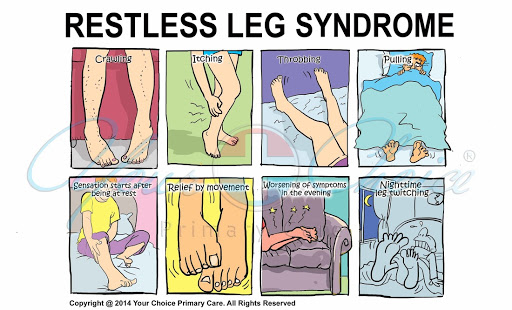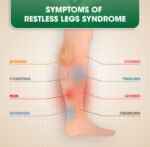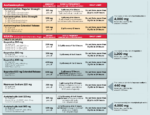Restless Legs Syndrome (RLS) is a neurological disorder causing uncomfortable sensations and an uncontrollable urge to move the legs, especially during rest or at night. It can significantly impact sleep and quality of life but is manageable with a combination of lifestyle changes, medications, and addressing underlying health conditions.

Research into Restless Legs Syndrome (RLS) is ongoing, as scientists and medical professionals seek to better understand the causes, improve diagnostic methods, and develop more effective treatments.
Here are some key areas of current research for RLS:
1. Genetic Studies
- Genetic Risk Factors: Researchers are investigating the genetic basis of RLS. Several genes have been identified that are associated with an increased risk of developing RLS, such as those involved in dopamine regulation, iron metabolism, and neurological signaling.
- Familial Links: There is a focus on families with a strong history of RLS to identify specific genetic markers that contribute to the condition. These studies aim to understand why some individuals are more susceptible to RLS than others.
- Future Gene Therapy: Identifying specific genetic factors may lead to the development of gene-targeted therapies in the future.
2. Neuroimaging Studies
- Brain Imaging: Neuroimaging techniques, such as functional MRI (fMRI) and positron emission tomography (PET) scans, are used to study the brain activity of individuals with RLS. These studies examine how RLS affects the brain’s dopamine pathways and iron levels.
- Iron Metabolism: Researchers are particularly interested in brain iron deficiencies, as low iron levels in certain brain regions are commonly associated with RLS. Imaging helps to pinpoint these deficiencies and understand their impact on RLS symptoms.
3. Iron Metabolism Research
- Iron Deficiency Link: Research into the role of iron in RLS is ongoing. Scientists are studying why some individuals have normal blood iron levels but still show a deficiency in the brain, which is linked to RLS symptoms.
- Iron Supplementation: Clinical trials are investigating the effectiveness of oral and intravenous iron supplementation in treating RLS, particularly in individuals with low ferritin levels.
- Novel Iron Delivery Methods: There is interest in developing new iron delivery methods that specifically target the brain to alleviate RLS symptoms more effectively.
4. Dopamine Pathways
- Dopaminergic System: Since dopamine plays a key role in RLS, studies are focusing on understanding how dopamine pathways are disrupted in individuals with RLS. This includes examining the role of dopamine receptors and transporters.
- Dopamine Agonists: Research is evaluating the long-term effectiveness and side effects of dopamine agonists, commonly used medications for RLS. The goal is to find ways to minimize augmentation (a worsening of symptoms with prolonged use of dopamine medications) and other side effects.
5. New Medications and Treatment Approaches
- New Medications: Clinical trials are underway for new medications that target different neurotransmitters or pathways involved in RLS. This includes exploring alternatives to current dopaminergic and anticonvulsant medications.
- Gabapentinoids: New formulations of gabapentin (e.g., gabapentin enacarbil) and pregabalin are being studied to improve symptom control and reduce side effects.

Gabapentin The Pill Imprint OE 800 - Non-Dopaminergic Treatments: Research is also focusing on non-dopaminergic treatments, such as glutamate modulators and opioid receptor antagonists, to provide additional options for patients who do not respond well to standard therapies.
6. Non-Pharmacological Interventions
- Lifestyle and Behavioral Approaches: Researchers are studying the impact of non-drug treatments, including cognitive-behavioral therapy (CBT), exercise, relaxation techniques, and other behavioral therapies on RLS symptoms.
- Transcranial Magnetic Stimulation (TMS): This non-invasive technique, which involves applying magnetic fields to stimulate nerve cells in the brain, is being tested for its potential to reduce RLS symptoms.
- Acupuncture and Other Complementary Therapies: Some research is examining the effectiveness of complementary therapies, such as acupuncture, yoga, or biofeedback, in managing RLS symptoms, particularly for those seeking non-drug approaches.
7. Improved Diagnostic Tools
- Biomarkers for RLS: Scientists are looking for reliable biomarkers—measurable indicators in blood, cerebrospinal fluid, or brain scans—that can help diagnose RLS more accurately and distinguish it from other conditions with similar symptoms.
- Objective Diagnostic Criteria: Efforts are underway to develop standardized diagnostic criteria and objective tests to identify RLS, reducing reliance on subjective symptom descriptions.
8. Augmentation and Medication Side Effects
- Understanding Augmentation: Augmentation, a phenomenon where RLS symptoms worsen over time with dopaminergic medication use, is a major focus. Research aims to understand why augmentation occurs and how to prevent or manage it.
- Alternative Dosing Regimens: Clinical trials are exploring different dosing strategies for existing medications to minimize side effects and augmentation, such as intermittent dosing or combination therapy.
9. Long-Term Studies and Epidemiology
- Natural History of RLS: Long-term studies are tracking the progression of RLS over time, identifying factors that may predict the severity, course, and impact of symptoms on quality of life.
- Population Studies: Epidemiological research is being conducted to better understand how common RLS is, who is most at risk, and how the disorder varies across different populations and demographics.
10. Sleep Research and RLS
- Impact of RLS on Sleep: Sleep research focuses on understanding how RLS affects sleep quality and patterns. Scientists are examining the link between RLS and sleep disorders like insomnia, sleep apnea, and periodic limb movement disorder (PLMD).
- Sleep Interventions: Studies are exploring specific sleep interventions that might alleviate RLS symptoms and improve overall sleep quality.
11. Multi-Disciplinary Approaches
- Combined Treatments: Researchers are investigating whether combining medications with non-pharmacological interventions, like exercise or CBT, provides better long-term outcomes for RLS patients.
- Tailored Treatment Plans: Personalized medicine approaches are being explored, aiming to develop tailored treatment plans based on genetic, biological, and lifestyle factors unique to each patient.
Key Takeaway
Research on Restless Legs Syndrome is multifaceted, ranging from genetic studies and brain imaging to novel treatments and improved diagnostic tools. The ultimate goal is to enhance the understanding of RLS’s causes, improve the effectiveness of treatments, reduce side effects, and find personalized solutions for those affected by the condition. As research progresses, it may lead to more targeted and effective therapies, offering better relief and quality of life for individuals with RLS.
Pain Medications, Pain Relief, and Pain Management









6u15ik
xh9ygm
vbl8nn